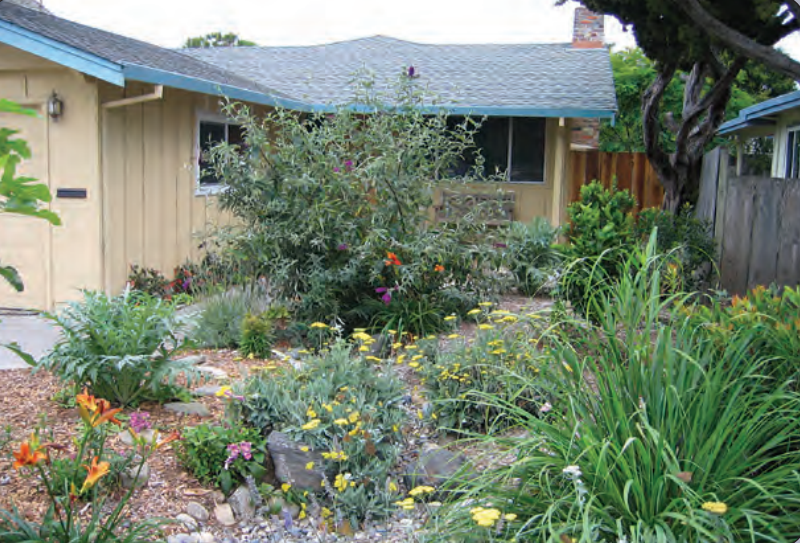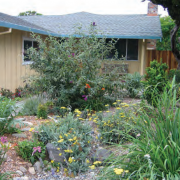Looking for a Little Peace? Plant a Rain Garden
The term “rain garden” may bring to mind images of tropical forests or elaborate garden water features. In reality, they are one of the easiest ways to improve your yard while protecting our creeks, streams and Russian River. They are also a great excuse to play in the garden.
Rain gardens filter, infiltrate, and slow the flow of storm water off your roof, patios and driveway. They provide a place to capture the water below ground and allow it to soak in naturally. Decorative plants are planted above this underground reservoir to help filter out pollutants before they can reach our natural waterways.
Ready to Plant A Rain Garden?

A rain garden starts with a good location such as under your roof downspout or near to your driveway. Pick a location where rainwater can be guided from these features to the rain garden. If your downspouts connect directly to an underground drainpipe, locate the rain garden anywhere along the length of that underground pipe.
The next step is to dig out the bed for the new rain garden. Bigger is better. The bigger the new garden bed the more rainwater can be captured. Then add the feature that makes a rain garden work, make the new garden 2’ to 4’ deep. Again, bigger is better. You can skip the gym after digging this garden bed. If you located your new garden bed along the underground drainpipe from your roof, then leave the pipe in place for now. Add a temporary support (a short length of 2×4 lumber works well) to keep the pipe from sagging and move on to the next step.
Now, partially fill the new garden bed with coarse drain rock or pea gravel. “Clean” rock is better; no dirt or fine sand. If you have an underground drainpipe, then drill several holes (about ½” in diameter) into the underside of the pipe before adding all of the rock. Remember, we want the rainwater to flow out of the pipe and prevent dirt from flowing into the pipe.
Add enough coarse drain rock to fill the new garden bed about halfway. If you have an underground drainpipe, then add enough drain rock to almost cover the pipe. Remember to drill those holes in the pipe before adding the rock.
Now for the fun part; add the garden soil right on top of the drain rock and plant your new plants. You can use any garden soil you like. Select plants that like an alternating wet and dry watering cycle. Annual flowering plants and perennial “no mow” grasses are great for rain gardens and add color. For a Homeowner’s and Landowner’s Guide to Beneficial Stormwater Management, a good selection tool for California native plants, and other landscape resources, visit www.rrwatershed.org/resource-library.
How A Rain Garden Works
A rain garden does three things; it filters the water coming off your roof, patio and/or driveway, it slows the flow of rainwater from your home to the local creeks or storm drain systems and it infiltrates much of the water directly into the ground.
Water from your roof, patio or driveway is guided into the rain garden where the plants and soil filter any debris. The filtered water then quickly sinks into the gravel below. The water will remain there for a few days while it continues to nourish the plants above and infiltrates into the soil below. After most storms the process ends here. Simple! However, after big storms the rain garden really shines.
When a big storm arrives, much of the water coming off your home will get trapped in the rain garden. The bigger your rain garden the bigger the storm it can handle. Eventually, the rain garden will overflow but it will continue to filter the water. The oil drips from your car, the bird doo from your roof or the wrapper you accidentally dropped will get captured in the garden. Only filtered water will flow out to our creeks or storm drain systems keeping them clean. It will also take longer for the water to reach our River reducing the peak flow and helping our River stay in its banks. Lastly, much of that water will infiltrate into the ground where it will re‑charge our groundwater ensuring that both we and the River have water in the drier months. There is a lot of good that can come from a simple garden.
Make a peaceful weekend for yourself by planting a rain garden in your yard. They don’t have to be mowed, weeds help them work and you can contribute to solving water pollution, drought and flooding. This is not an overstatement, there really is a lot of good that can come from a simple garden.
This article was authored by Eric Janzen of the City of Cloverdale, on behalf of RRWA. RRWA (www.rrwatershed.org) is an association of local public agencies in the Russian River Watershed that have come together to coordinate regional programs for clean water, habitat restoration, and watershed enhancement.




